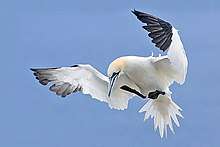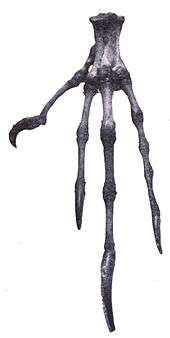Suliformes
The order Suliformes (dubbed "Phalacrocoraciformes" by Christidis & Boles 2008) is an order recognised by the International Ornithologist's Union.[1] In regard to the recent evidence that the traditional Pelecaniformes is polyphyletic,[2] it has been suggested that the group be split up to reflect the true evolutionary relationships.
| Suliformes | |
|---|---|
 | |
| Northern gannet (Morus bassanus) | |
| Scientific classification | |
| Kingdom: | Animalia |
| Phylum: | Chordata |
| Class: | Aves |
| Clade: | Aequornithes |
| Order: | Suliformes Sharpe, 1891 |
| Families | |
Systematics and evolution
Of the families in Pelecaniformes, only Pelecanidae, Balaenicipitidae, and Scopidae remain. The tropicbird family Phaethontidae has since been moved to their own order Phaethontiformes. Genetic analysis seems to show that the Pelecaniformes is actually closely related to the Ardeidae and Threskiornithidae. As for the Suliformes, they are distantly related to the current Pelecaniformes.[3] According to Hackett et al. (2008), loons, penguins, storks, and as well as Suliformes and Pelecaniformes, all seem to have evolved from a common ancestor. The proposed waterbird superorder has been suggested.[4]
In their landmark 2008 work Systematics and Taxonomy of Australian Birds, Australian ornithologists Les Christidis and Walter E. Boles coined the name Phalacrocoraciformes for the group due to the much greater number of species of cormorants (Phalacrocoracidae) over boobies and gannets (Sulidae).[5] However, this has not been taken up elsewhere.
In 1994, American ornithologist Walter J. Bock wrote that the name Suloidea had been used consistently as a term for a superfamily containing the two families, so therefore "Sulidae" and not "Phalacrocoracidae" should take priority in any arrangement containing the two genera.[6]
In 2010, the AOU adopted the term Suliformes for the taxon.[7] The IOC followed in 2011.[8]
In 1994, Martyn Kennedy and colleagues constructed a behavioural data set, with the resulting tree showing a high level of congruence with existing phylogenies based on genetics or morphology. It showed the darters as sister group to the cormorants and shags, with the gannets and boobies, then pelicans, then frigatebirds and lastly tropicbirds as progressively earlier offshoots.[9]
| Suliformes |
| ||||||||||||||||||
Species
- Fregatidae
- Magnificent frigatebird or man o'war, Fregata magnificens
- Ascension frigatebird, Fregata aquila
- Christmas Island frigatebird, Fregata andrewsi
- Great frigatebird, Fregata minor
- Lesser frigatebird, Fregata ariel
- Sulidae
- Blue-footed booby, Sula nebouxii
- Peruvian booby, Sula variegata
- Masked booby, Sula dactylatra
- Nazca booby, Sula granti
- Red-footed booby, Sula sula
- Brown booby, Sula leucogaster
- Abbott's booby, Papasula abbotti
- Northern gannet, Morus bassanus
- Cape gannet, Morus capensis
- Australasian gannet, Morus serrator
_in_Hyderabad_W_IMG_8389.jpg)
- Phalacrocoracidae
- Double-crested cormorant or white-crested cormorant, Phalacrocorax auritus
- Neotropic cormorant or olivaceous cormorant, Phalacrocorax brasilianus (or Phalacrocorax olivaceus)
- Little black cormorant, Phalacrocorax sulcirostris
- Great cormorant or black shag, Phalacrocorax carbo
- White-breasted cormorant, Phalacrocorax lucidus
- Indian cormorant, Phalacrocorax fuscicollis
- Cape cormorant, Phalacrocorax capensis
- Socotra cormorant, Phalacrocorax nigrogularis
- Wahlberg's cormorant or bank cormorant, Phalacrocorax neglectus
- Temminck's cormorant or Japanese cormorant, Phalacrocorax capillatus
- Brandt's cormorant, Phalacrocorax penicillatus
- Spectacled cormorant, Phalacrocorax perspicillatus - extinct (c. 1850)
- Common shag, Phalacrocorax aristotelis
- Pelagic cormorant or Baird's cormorant, Phalacrocorax pelagicus
- Red-faced cormorant, Phalacrocorax urile
- Rock shag, Phalacrocorax magellanicus
- Guanay cormorant, Phalacrocorax bougainvillii
- Pied cormorant or yellow-faced cormorant, Phalacrocorax varius
- Black-faced cormorant, Phalacrocorax fuscescens
- King shag or rough-faced shag, Phalacrocorax carunculatus
- Stewart Island shag, Phalacrocorax chalconotus
- Chatham shag, Phalacrocorax onslowi
- Auckland shag, Phalacrocorax colensoi
- Campbell shag, Phalacrocorax campbelli
- Bounty shag, Phalacrocorax ranfurlyi
- Imperial shag or blue-eyed shag, Phalacrocorax atriceps
- White-bellied shag, Phalacrocorax atriceps albiventer
- Antarctic shag, Phalacrocorax bransfieldensis
- South Georgia shag, Phalacrocorax georgianus
- Heard shag, Phalacrocorax nivalis
- Crozet shag, Phalacrocorax melanogenis
- Kerguelen shag, Phalacrocorax verrucosus
- Macquarie shag, Phalacrocorax purpurascens
- Red-legged cormorant, Phalacrocorax gaimardi
- Spotted shag Phalacrocorax punctatus
- Pitt shag or Featherstone's shag Phalacrocorax featherstoni
- Little pied cormorant, Phalacrocorax melanoleucos
- Long-tailed cormorant, Phalacrocorax africanus
- Crowned cormorant, Phalacrocorax coronatus
- Little cormorant, Phalacrocorax niger
- Pygmy cormorant, Phalacrocorax pygmaeus
- Flightless cormorant, Phalacrocorax harrisi
- Anhingidae
- Anhinga or American darter, Anhinga anhinga
- Oriental darter or Indian darter, Anhinga melanogaster
- African darter, Anhinga rufa
- Australasian darter or Australian darter, Anhinga novaehollandiae
References
- "Archived copy". Archived from the original on 2012-03-01. Retrieved 2012-03-01.CS1 maint: archived copy as title (link)
- Mayr (2003)
- Jarvis, E.D. et al. (2014) Whole-genome analyses resolve early branches in the tree of life of modern birds. Science, 346(6215):1320-1331. DOI: 10.1126/science.1253451
- Hackett, S.J. et al. (2008) A Phylogenomic Study of Birds Reveals Their Evolutionary History. Science 320, 1763.
- Christidis, Les; Boles, Walter E. (2008). Systematics and Taxonomy of Australian Birds. Canberra: CSIRO Publishing. p. 50. ISBN 978-0-643-06511-6.
- Bock, Walter J. (1994). "History and nomenclature of avian family-group names". Bulletin of the American Museum of Natural History. 222: 1–281 [166–67].
If Sula and Phalacrocorax are included in the same family-level taxon (e.g. superfamily), then Sulidae Reichenbach, 1849 (1836) (Sula Brisson, 1760) has priority in preference to Phalacrocoracidae Reichenbach, 1849-50 (1836) (Phalacrocorax Brisson, 1760), because the name Suloidea has been consistently used in avian classification as a superfamily name. Phalacrocoracidae Reichenbach, 1849-50 (1836) can still be used for any taxon containing Phalacrocorax but not Sula.
- R. Terry Chesser, Richard C. Banks, F. Keith Barker, Carla Cicero, Jon L. Dunn, Andrew W. Kratter, Irby J. Lovette, Pamela C. Rasmussen, J. V. Remsen Jr., James D. Rising, Douglas F. Stotz and Kevin Winker (July 2010). "Fifty-First Supplement to the American Ornithologists' Union Check-List of North American Birds" (PDF). The Auk. 127 (3): 726–44. doi:10.1525/auk.2010.127.4.966.CS1 maint: multiple names: authors list (link)
- "Taxonomy Version 2". IOC World Bird List: Version 3.1. 2011. Retrieved 15 July 2012.
- Kennedy, Martyn; Spencer, Hamish G.; Gray, Russell D. (1996). "Hop, step and gape: do the social displays of the Pelecaniformes reflect phylogeny?" (PDF). Animal Behaviour. 51 (2): 273–291. doi:10.1006/anbe.1996.0028.
- Gibb, Gillian C.; Kennedy, Martyn; Penny, David (2013). "Beyond phylogeny: Pelecaniform and ciconiiform birds, and long-term niche stability". Molecular Phylogenetics and Evolution. 68 (2): 229–238. doi:10.1016/j.ympev.2013.03.021. PMID 23562800.
- Shufeldt, Robert Wilson (1903). "The osteology of the Steganopodes". Memoirs of the Carnegie Museum. 1 (3): 109–223.
- Mayr, Gerald (2008). "Avian higher-level phylogeny: well-supported clades and what we can learn from a phylogenetic analysis of 2954 morphological characters" (PDF). J. Zool. Syst. Evol. Res. 46 (1): 63–72. doi:10.1111/j.1439-0469.2007.00433.x.
